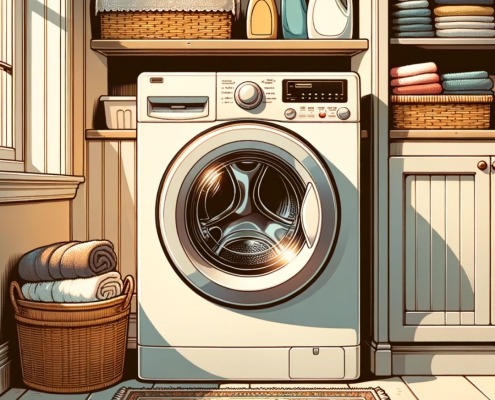How to replace a Whirlpool washer suspension spring
Steven E / Tuesday April 22, 2025
Is your Whirlpool washer shaking dangerously during its spin cycle or making unsettling noises? Don’t rush to call a repairman—learn how to replace the suspension spring yourself, restoring balance and peace to your laundry routine. With just a few tools and guidance from our step-by-step how-to video below, you’ll have your washer back to running smoothly in no time!
Looking for the right part? Enter your appliance model number below to find the exact match and get your appliance running like new again!
On a Whirlpool washer, the suspension spring is responsible for stabilizing the tub assembly, reducing vibrations and movement during the spin cycle.
Common signs that indicate the need for replacement include excessive vibration, loud noises during the spin cycle, or the tub becoming off-balance.
Fortunately, with a few basic tools and some patience, you can tackle this repair yourself and get your washer back in working order. So, let’s get started!
You can find a replacement suspension spring here. If you need other replacement parts for your Whirlpool washer, just enter your model number at AppliancePartsPros.com to find them. It’s that easy! Most orders arrive in just two business days, and we have thousands of guides to show you how to install your new parts.
Watch here: How To: Whirlpool/KitchenAid/Maytag Suspension Spring WPW10250667
The information in this article may not apply to your specific appliance model. We recommend consulting your manufacturer’s documentation or contact us with any questions.
Tools and materials
- Replacement part (make sure it’s compatible with your model before installing)
- Flat head screwdriver
- Phillips screwdriver
- Pliers
Safety precautions
When working on any appliance, remember to keep safety first. Here are some tips to keep in mind:
- Always power off and unplug your appliance or switch off the circuit breaker before attempting any maintenance or replacement work. This keeps you safe by preventing any risk of injury from electric shock.
- Turn off the water supply at the outlet before beginning repairs to any appliance parts that hold water. Have towels ready for any residual water in the system when removing parts.
- Wear insulated work gloves to protect your hands from sharp metal parts, pinching hazards and debris.
- Don’t test wiring with a multimeter for live voltage if you’re unfamiliar with how to prevent short circuiting when testing.
- When working with wires, avoid touching any exposed wires or terminals. If you need to touch a wire, use a non-conductive tool or wear insulating gloves to prevent electrical shock.
- Take your time and don’t rush while working to prevent accidents and personal injuries.
- Work in a well-lit area so you can clearly see and access the interior parts.
- Clear your workspace of clutter and other obstacles. Keep children and pets away from the work area.
- Never work on internal parts with bare wet hands. Make sure the work area is completely dry.
- Check your user manual to see if there are specific installation or safety instructions for your part or appliance.
- Be gentle when handling or removing parts. Excessive force might damage the appliance or cause injury.
- Wear safety glasses when working with chemicals, dust or cleaning large debris to prevent injury.
- If the appliance has recently been used, give it plenty of time for any heating parts to cool down before working on it.
- Take pictures or make a note of wiring connections before disconnecting to prevent any problems with reassembly.
Replacement steps
Step 1: Disassembly
- Remove the two screws holding the control panel in place at the front and rear.
- Lift off any trim covers or use a putty knife to release spring clips.
- Slide the control panel forward about 1/2 an inch and lift it back over the back of the machine.
- Disconnect the lid switch and use a flathead screwdriver to pry out the two retaining spring clips that hold the body to the frame.
- Lift up on the lid, grab the body near the front, put your foot against the body of the machine, tilt the body back to about a 45-degree angle, and carefully lift it off the washer.
- Locate the counterbalance spring and disconnect the lower end. If the lower part of the spring is worn out, it may already be disconnected.
- To remove the upper end of the spring, simply take it out of the hole. If the hole is rusted out, you may need to drill a small hole next to it or hook the new spring into the frame.
Step 2: Reassembly
- Hook the top of the spring into the bracket and stretch the lower half down with pliers. Hook the lower end of the spring into the frame.
- If the hole is rusted out, you can try drilling a second hole or stretching the spring to the side to create tension on the tub.
- Hold the cabinet at a 45-degree angle and swing it back onto the washing machine.
- When sliding the body back onto the frame, ensure the lower lip is underneath the frame and lower it onto the four locking tabs.
- Hook the retaining spring clips onto the back panel and use a flathead screwdriver to push them down into place.
- Reconnect the lid switch.
- Rotate the control panel forward over the front of the machine, ensuring the locking tabs lock in place. Pull it back about half an inch and replace the screws.
- Plug the washer back in and turn the water back on.
- Test the washer to check for any problems.
Additional information
Thanks for reading! We hope this guide helped you replace the suspension spring on your Whirlpool washer.
If you still need some replacement parts, grab your model number and head over to AppliancePartsPros.com. We offer over two million parts and most orders arrive in two business days. If you need some help with finding the right part or placing an order, you can contact our team at 1 (877) 477-7278.
While you’re waiting for your new part to arrive, you can explore our DIY blog and watch thousands of video tutorials on our YouTube channel.
Be sure to follow us on Facebook, Twitter and Instagram to see our latest repair guides!
With nearly a decade of experience in providing top-notch customer service regarding appliance parts and repair, Steven enjoys sharing practical advice, troubleshooting tips, and interesting information to help readers stay informed.





